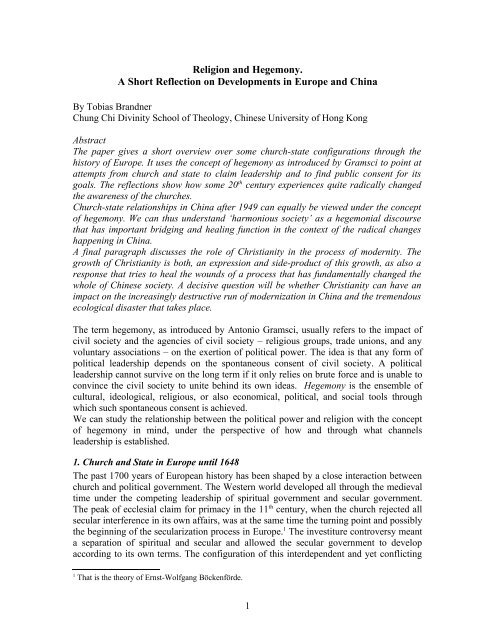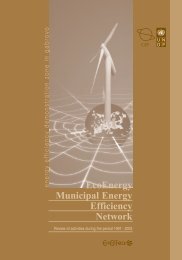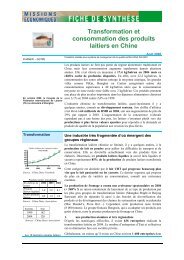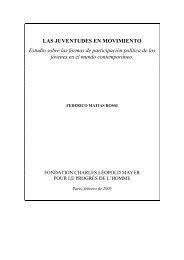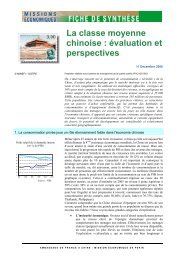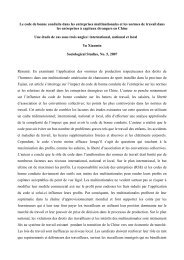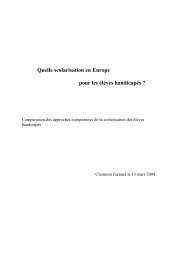Religion and Hegemony. A Short Reflection on Developments in ...
Religion and Hegemony. A Short Reflection on Developments in ...
Religion and Hegemony. A Short Reflection on Developments in ...
Create successful ePaper yourself
Turn your PDF publications into a flip-book with our unique Google optimized e-Paper software.
<str<strong>on</strong>g>Religi<strong>on</strong></str<strong>on</strong>g> <str<strong>on</strong>g>and</str<strong>on</strong>g> <str<strong>on</strong>g>Hegem<strong>on</strong>y</str<strong>on</strong>g>.<br />
A <str<strong>on</strong>g>Short</str<strong>on</strong>g> <str<strong>on</strong>g>Reflecti<strong>on</strong></str<strong>on</strong>g> <strong>on</strong> <strong>Developments</strong> <strong>in</strong> Europe <str<strong>on</strong>g>and</str<strong>on</strong>g> Ch<strong>in</strong>a<br />
By Tobias Br<str<strong>on</strong>g>and</str<strong>on</strong>g>ner<br />
Chung Chi Div<strong>in</strong>ity School of Theology, Ch<strong>in</strong>ese University of H<strong>on</strong>g K<strong>on</strong>g<br />
Abstract<br />
The paper gives a short overview over some church-state c<strong>on</strong>figurati<strong>on</strong>s through the<br />
history of Europe. It uses the c<strong>on</strong>cept of hegem<strong>on</strong>y as <strong>in</strong>troduced by Gramsci to po<strong>in</strong>t at<br />
attempts from church <str<strong>on</strong>g>and</str<strong>on</strong>g> state to claim leadership <str<strong>on</strong>g>and</str<strong>on</strong>g> to f<strong>in</strong>d public c<strong>on</strong>sent for its<br />
goals. The reflecti<strong>on</strong>s show how some 20 th century experiences quite radically changed<br />
the awareness of the churches.<br />
Church-state relati<strong>on</strong>ships <strong>in</strong> Ch<strong>in</strong>a after 1949 can equally be viewed under the c<strong>on</strong>cept<br />
of hegem<strong>on</strong>y. We can thus underst<str<strong>on</strong>g>and</str<strong>on</strong>g> ‘harm<strong>on</strong>ious society’ as a hegem<strong>on</strong>ial discourse<br />
that has important bridg<strong>in</strong>g <str<strong>on</strong>g>and</str<strong>on</strong>g> heal<strong>in</strong>g functi<strong>on</strong> <strong>in</strong> the c<strong>on</strong>text of the radical changes<br />
happen<strong>in</strong>g <strong>in</strong> Ch<strong>in</strong>a.<br />
A f<strong>in</strong>al paragraph discusses the role of Christianity <strong>in</strong> the process of modernity. The<br />
growth of Christianity is both, an expressi<strong>on</strong> <str<strong>on</strong>g>and</str<strong>on</strong>g> side-product of this growth, as also a<br />
resp<strong>on</strong>se that tries to heal the wounds of a process that has fundamentally changed the<br />
whole of Ch<strong>in</strong>ese society. A decisive questi<strong>on</strong> will be whether Christianity can have an<br />
impact <strong>on</strong> the <strong>in</strong>creas<strong>in</strong>gly destructive run of modernizati<strong>on</strong> <strong>in</strong> Ch<strong>in</strong>a <str<strong>on</strong>g>and</str<strong>on</strong>g> the tremendous<br />
ecological disaster that takes place.<br />
The term hegem<strong>on</strong>y, as <strong>in</strong>troduced by Ant<strong>on</strong>io Gramsci, usually refers to the impact of<br />
civil society <str<strong>on</strong>g>and</str<strong>on</strong>g> the agencies of civil society – religious groups, trade uni<strong>on</strong>s, <str<strong>on</strong>g>and</str<strong>on</strong>g> any<br />
voluntary associati<strong>on</strong>s – <strong>on</strong> the exerti<strong>on</strong> of political power. The idea is that any form of<br />
political leadership depends <strong>on</strong> the sp<strong>on</strong>taneous c<strong>on</strong>sent of civil society. A political<br />
leadership cannot survive <strong>on</strong> the l<strong>on</strong>g term if it <strong>on</strong>ly relies <strong>on</strong> brute force <str<strong>on</strong>g>and</str<strong>on</strong>g> is unable to<br />
c<strong>on</strong>v<strong>in</strong>ce the civil society to unite beh<strong>in</strong>d its own ideas. <str<strong>on</strong>g>Hegem<strong>on</strong>y</str<strong>on</strong>g> is the ensemble of<br />
cultural, ideological, religious, or also ec<strong>on</strong>omical, political, <str<strong>on</strong>g>and</str<strong>on</strong>g> social tools through<br />
which such sp<strong>on</strong>taneous c<strong>on</strong>sent is achieved.<br />
We can study the relati<strong>on</strong>ship between the political power <str<strong>on</strong>g>and</str<strong>on</strong>g> religi<strong>on</strong> with the c<strong>on</strong>cept<br />
of hegem<strong>on</strong>y <strong>in</strong> m<strong>in</strong>d, under the perspective of how <str<strong>on</strong>g>and</str<strong>on</strong>g> through what channels<br />
leadership is established.<br />
1. Church <str<strong>on</strong>g>and</str<strong>on</strong>g> State <strong>in</strong> Europe until 1648<br />
The past 1700 years of European history has been shaped by a close <strong>in</strong>teracti<strong>on</strong> between<br />
church <str<strong>on</strong>g>and</str<strong>on</strong>g> political government. The Western world developed all through the medieval<br />
time under the compet<strong>in</strong>g leadership of spiritual government <str<strong>on</strong>g>and</str<strong>on</strong>g> secular government.<br />
The peak of ecclesial claim for primacy <strong>in</strong> the 11 th century, when the church rejected all<br />
secular <strong>in</strong>terference <strong>in</strong> its own affairs, was at the same time the turn<strong>in</strong>g po<strong>in</strong>t <str<strong>on</strong>g>and</str<strong>on</strong>g> possibly<br />
the beg<strong>in</strong>n<strong>in</strong>g of the secularizati<strong>on</strong> process <strong>in</strong> Europe. 1 The <strong>in</strong>vestiture c<strong>on</strong>troversy meant<br />
a separati<strong>on</strong> of spiritual <str<strong>on</strong>g>and</str<strong>on</strong>g> secular <str<strong>on</strong>g>and</str<strong>on</strong>g> allowed the secular government to develop<br />
accord<strong>in</strong>g to its own terms. The c<strong>on</strong>figurati<strong>on</strong> of this <strong>in</strong>terdependent <str<strong>on</strong>g>and</str<strong>on</strong>g> yet c<strong>on</strong>flict<strong>in</strong>g<br />
1<br />
That is the theory of Ernst-Wolfgang Böckenförde.<br />
1
elati<strong>on</strong>ship radically changed with the Peace of Westphalia <strong>in</strong> 1648 that brought the<br />
c<strong>on</strong>fessi<strong>on</strong>al wars after the Reformati<strong>on</strong> <strong>in</strong> c<strong>on</strong>t<strong>in</strong>ental Europe to an end. The importance<br />
of the Peace of Westphalia was to limit the churches <str<strong>on</strong>g>and</str<strong>on</strong>g> their political power after their<br />
c<strong>on</strong>flicts had brought such tremendous suffer<strong>in</strong>g over the people of Europe.<br />
This is <strong>in</strong> radical c<strong>on</strong>trast to the development <strong>in</strong> the US: Based <strong>on</strong> their experience of religious<br />
persecuti<strong>on</strong> the Europeans migrat<strong>in</strong>g to the US developed a political system that should precisely<br />
prevent any government from <strong>in</strong>terfer<strong>in</strong>g <strong>in</strong> the affairs of the church. The political system <strong>in</strong> Europe <strong>in</strong><br />
c<strong>on</strong>trast wanted to prevent the churches ever to br<strong>in</strong>g so deep destructi<strong>on</strong> over Europe.<br />
The history of the church-state relati<strong>on</strong>ship was shaped by the mutual attempt to use the<br />
other side for own <strong>in</strong>terests: The political government used the church for social<br />
stratificati<strong>on</strong>, as social stabilizer, as tool for warfare, or as legitimati<strong>on</strong> for expansi<strong>on</strong>.<br />
The spiritual government used the political government to protect its properties <str<strong>on</strong>g>and</str<strong>on</strong>g> to<br />
support its spiritual expansi<strong>on</strong>.<br />
2. Church <str<strong>on</strong>g>and</str<strong>on</strong>g> State <strong>in</strong> Europe <strong>in</strong> the C<strong>on</strong>text of Modernity<br />
The beg<strong>in</strong>n<strong>in</strong>g secularizati<strong>on</strong> process that started <strong>in</strong> the 17 th century signified a radical<br />
shift <strong>in</strong> the relati<strong>on</strong>ship between church <str<strong>on</strong>g>and</str<strong>on</strong>g> state <str<strong>on</strong>g>and</str<strong>on</strong>g> at least superficially a tremendous<br />
shift <strong>in</strong> authority towards the political leadership.<br />
The church reacted <str<strong>on</strong>g>and</str<strong>on</strong>g> c<strong>on</strong>t<strong>in</strong>ued to develop with a fluctuat<strong>in</strong>g role:<br />
a) Partly the churches ma<strong>in</strong>ta<strong>in</strong>ed a self-underst<str<strong>on</strong>g>and</str<strong>on</strong>g><strong>in</strong>g as received from traditi<strong>on</strong>, the role of<br />
embrac<strong>in</strong>g the whole of society <str<strong>on</strong>g>and</str<strong>on</strong>g> to provide spiritual leadership to the whole of society.<br />
However, it accepted the leadership of the political realm <str<strong>on</strong>g>and</str<strong>on</strong>g> filled <strong>in</strong> the niches <str<strong>on</strong>g>and</str<strong>on</strong>g> the<br />
gaps that were left empty. The church offered care where special needs arose, provided<br />
mean<strong>in</strong>g where cold rati<strong>on</strong>ality came to its limits, <str<strong>on</strong>g>and</str<strong>on</strong>g> represented the spiritual dimensi<strong>on</strong><br />
vis-à-vis society. This is the story of the so-called ‘state churches’.<br />
b) Partly the churches withdrew from def<strong>in</strong><strong>in</strong>g herself <strong>in</strong> relati<strong>on</strong> to the overall society <str<strong>on</strong>g>and</str<strong>on</strong>g><br />
set up an alternative community. This community was equally car<strong>in</strong>g for society at large,<br />
but didn’t underst<str<strong>on</strong>g>and</str<strong>on</strong>g> herself as gather<strong>in</strong>g the whole of society. Rather this community<br />
stood <strong>in</strong> c<strong>on</strong>trast to many of the dom<strong>in</strong>ant values of society. This is the story of the socalled<br />
‘free churches’.<br />
Comments<br />
1. The dual development of the church didn’t start with modernity; rather the whole church history from<br />
the time of C<strong>on</strong>stant<strong>in</strong>e can be read under the perspective of a dualism between church as a more<br />
<strong>in</strong>tegrat<strong>in</strong>g community <str<strong>on</strong>g>and</str<strong>on</strong>g> church as an alternative community. However, after the emergence of<br />
Protestantism <str<strong>on</strong>g>and</str<strong>on</strong>g> various Protestant churches the dualism became a dom<strong>in</strong>ant factor <strong>in</strong> the churches’<br />
development.<br />
2. The duality is not an exclusive duality. Although the dual history of Christianity is full of tensi<strong>on</strong>s,<br />
<strong>in</strong>clud<strong>in</strong>g reciprocal c<strong>on</strong>demnati<strong>on</strong>s, the <strong>in</strong>teracti<strong>on</strong> between the two forms of development often<br />
<strong>in</strong>spired each other <str<strong>on</strong>g>and</str<strong>on</strong>g> was based <strong>on</strong> mutual respect. Many diac<strong>on</strong>ical m<strong>in</strong>istries emerged from the<br />
free churches <str<strong>on</strong>g>and</str<strong>on</strong>g> <strong>in</strong>spired the state churches. Many pers<strong>on</strong>s fluctuated between the two sides.<br />
3. The <strong>in</strong>teracti<strong>on</strong> between a church that was close to the political establishment <str<strong>on</strong>g>and</str<strong>on</strong>g> a church st<str<strong>on</strong>g>and</str<strong>on</strong>g><strong>in</strong>g <strong>in</strong><br />
critical distance to it <strong>in</strong>spired a dynamic <str<strong>on</strong>g>and</str<strong>on</strong>g> rich development with<strong>in</strong> <strong>in</strong> the church <str<strong>on</strong>g>and</str<strong>on</strong>g> bey<strong>on</strong>d. Even<br />
the development of Enlightenment th<strong>in</strong>k<strong>in</strong>g, although <strong>in</strong> many ways <strong>in</strong> c<strong>on</strong>trast to faith, emphasiz<strong>in</strong>g<br />
<strong>in</strong>stead the power of reas<strong>on</strong>, <str<strong>on</strong>g>and</str<strong>on</strong>g> the subsequently start<strong>in</strong>g process of secularizati<strong>on</strong> that radically<br />
transformed Europe <str<strong>on</strong>g>and</str<strong>on</strong>g> its <strong>in</strong>stituti<strong>on</strong>s, cannot be understood without the c<strong>on</strong>tributi<strong>on</strong>s from these two<br />
different traditi<strong>on</strong>s of Christianity.<br />
4. The dual development of state churches <str<strong>on</strong>g>and</str<strong>on</strong>g> free churches is str<strong>on</strong>ger <strong>in</strong> Protestant areas, but not<br />
restricted to them. Free Church movements exist also <strong>in</strong> traditi<strong>on</strong>al Catholic areas. The difference is<br />
that the Catholic Church absorbs them as spiritual movements with<strong>in</strong> the church.<br />
2
Both k<strong>in</strong>ds of churches, ‘state churches’ <str<strong>on</strong>g>and</str<strong>on</strong>g> ‘free churches’ are subject to hegem<strong>on</strong>ial<br />
claims by the political leadership <str<strong>on</strong>g>and</str<strong>on</strong>g> to attempts of turn<strong>in</strong>g them <strong>in</strong>to elements of a<br />
dom<strong>in</strong>ant discourse – political, ec<strong>on</strong>omical, or else. The state churches are, however,<br />
more vulnerable to be<strong>in</strong>g functi<strong>on</strong>alized as they def<strong>in</strong>e themselves as hav<strong>in</strong>g an<br />
<strong>in</strong>tegrat<strong>in</strong>g functi<strong>on</strong>.<br />
3. Church <str<strong>on</strong>g>and</str<strong>on</strong>g> State <strong>in</strong> the 20 th <str<strong>on</strong>g>and</str<strong>on</strong>g> Early 21 st Century<br />
Several experiences shaped the church-state c<strong>on</strong>figurati<strong>on</strong> <strong>in</strong> the 20 th century:<br />
The most important experience was the relative failure of the churches to raise their<br />
voices aga<strong>in</strong>st the totalitarianism of Nazism, Fascism, <str<strong>on</strong>g>and</str<strong>on</strong>g> Bolshevism. The critical<br />
self-reflecti<strong>on</strong> after WWII led the state churches <strong>in</strong> parts of Western Europe to<br />
recover their prophetic role <strong>in</strong> relati<strong>on</strong> to the state.<br />
The process of European <strong>in</strong>tegrati<strong>on</strong> <str<strong>on</strong>g>and</str<strong>on</strong>g> the wider parallel process of globalizati<strong>on</strong><br />
sharpened the churches’ awareness of st<str<strong>on</strong>g>and</str<strong>on</strong>g><strong>in</strong>g <strong>in</strong> a dynamic <strong>in</strong>teracti<strong>on</strong> with<strong>in</strong> a<br />
multicultural <str<strong>on</strong>g>and</str<strong>on</strong>g> multireligious society.<br />
The European experience with totalitarian governments <str<strong>on</strong>g>and</str<strong>on</strong>g> the development of a highly<br />
diverse society with<strong>in</strong> a unify<strong>in</strong>g Europe has taught the churches to be sensitive to all<br />
k<strong>in</strong>ds of totalitarianisms –be it the totalitarianisms of ec<strong>on</strong>omic rati<strong>on</strong>ality, an exclusivist<br />
underst<str<strong>on</strong>g>and</str<strong>on</strong>g><strong>in</strong>gs of Europe, or the authoritarian claim of any particular traditi<strong>on</strong>.<br />
The attempts for hegem<strong>on</strong>ial leadership <strong>in</strong> Europe naturally c<strong>on</strong>t<strong>in</strong>ue, <str<strong>on</strong>g>and</str<strong>on</strong>g> with it the<br />
political attempts to give directi<strong>on</strong> to the churches. After the political experiences of the<br />
past century attempts to give directi<strong>on</strong> to the churches from outside are usually met with<br />
higher awareness about the risks of be<strong>in</strong>g def<strong>in</strong>ed through political means.<br />
An Example<br />
If Jacques Delors, the former president of the European Commissi<strong>on</strong>, <strong>in</strong>vites the churches to provide a<br />
spiritual dimensi<strong>on</strong> to the dom<strong>in</strong>antly ec<strong>on</strong>omical <str<strong>on</strong>g>and</str<strong>on</strong>g> technocratic <strong>in</strong>terests of the process of European<br />
Unificati<strong>on</strong> he will be met friendly <str<strong>on</strong>g>and</str<strong>on</strong>g> skeptically: Friendly, because the churches underst<str<strong>on</strong>g>and</str<strong>on</strong>g> that<br />
growth <strong>in</strong> spirituality is a crucial element of any holistic growth process; skeptically, because the<br />
<strong>in</strong>vitati<strong>on</strong> smells of a political def<strong>in</strong>iti<strong>on</strong> of the task <str<strong>on</strong>g>and</str<strong>on</strong>g> resp<strong>on</strong>sibility of the churches. The churches<br />
are, receiv<strong>in</strong>g such an <strong>in</strong>vitati<strong>on</strong>, supposed to fill <strong>in</strong> the gaps that the political <str<strong>on</strong>g>and</str<strong>on</strong>g> ec<strong>on</strong>omic process<br />
has left.<br />
The role of the churches / religi<strong>on</strong>s is first to underst<str<strong>on</strong>g>and</str<strong>on</strong>g> this hegem<strong>on</strong>ial process, <str<strong>on</strong>g>and</str<strong>on</strong>g><br />
then to c<strong>on</strong>trast it with an alternative project, <strong>on</strong>e that is based <strong>on</strong> the values of the<br />
religious traditi<strong>on</strong>.<br />
The questi<strong>on</strong>s that churches <str<strong>on</strong>g>and</str<strong>on</strong>g> religi<strong>on</strong>s alike c<strong>on</strong>t<strong>in</strong>uously discuss <strong>in</strong> the process of a<br />
unify<strong>in</strong>g Europe, <str<strong>on</strong>g>and</str<strong>on</strong>g> <strong>on</strong> the background of the special experiences of the past centuries,<br />
are:<br />
• What does ‘Europe’ st<str<strong>on</strong>g>and</str<strong>on</strong>g> for<br />
• What are the essentials of the project of a unify<strong>in</strong>g Europe<br />
• Who def<strong>in</strong>es what Europe st<str<strong>on</strong>g>and</str<strong>on</strong>g>s for<br />
• What are the values of Europe<br />
• What are the borders of Europe<br />
Christian churches additi<strong>on</strong>ally ask more particularly:<br />
• As Christianity fundamentally shaped the history <str<strong>on</strong>g>and</str<strong>on</strong>g> development of Europe,<br />
what is its role now when Europe becomes more multi-religious<br />
3
4. State <str<strong>on</strong>g>and</str<strong>on</strong>g> <str<strong>on</strong>g>Religi<strong>on</strong></str<strong>on</strong>g> <strong>in</strong> Ch<strong>in</strong>a after 1949<br />
The dom<strong>in</strong>ance of the Communist Party shaped the relati<strong>on</strong>ship between church <str<strong>on</strong>g>and</str<strong>on</strong>g> state<br />
<strong>in</strong> modern Ch<strong>in</strong>a. In the absence of a democratically def<strong>in</strong>ed representati<strong>on</strong> of the<br />
different parts of society other channels were necessary for the political leadership to<br />
<strong>in</strong>tegrate the different movements of civil society <strong>in</strong> its own visi<strong>on</strong> of the New Ch<strong>in</strong>a, <strong>in</strong><br />
the case of religious groups most importantly agencies like the United Fr<strong>on</strong>t Department<br />
of the CP.<br />
The importance of gather<strong>in</strong>g the diverse social <strong>in</strong>terest beh<strong>in</strong>d the dom<strong>in</strong>ant leadership<br />
has <strong>in</strong> the past years tremendously grown. The most important reas<strong>on</strong>s are:<br />
a) S<strong>in</strong>ce the ec<strong>on</strong>omic open<strong>in</strong>g of Ch<strong>in</strong>a 30 years ago the diversity of the Ch<strong>in</strong>ese<br />
society has grown exp<strong>on</strong>entially. To unite an <strong>in</strong>creas<strong>in</strong>gly complex, divers, <str<strong>on</strong>g>and</str<strong>on</strong>g><br />
affluent society beh<strong>in</strong>d the goals of <strong>on</strong>e party has become <strong>in</strong>creas<strong>in</strong>gly difficult.<br />
b) Parallel to the growth of a more diverse society a tremendous growth of religious<br />
life emerged. Ch<strong>in</strong>a experiences at present an enormous growth of Christian faith<br />
<str<strong>on</strong>g>and</str<strong>on</strong>g> estimati<strong>on</strong> about the number of Christians <strong>in</strong> Ch<strong>in</strong>a, Protestant <str<strong>on</strong>g>and</str<strong>on</strong>g> Roman-<br />
Catholic, go up to 80 or 100 Mio. Besides the growth <strong>in</strong> Christian churches there<br />
is a similar, even if numerically lesser growth <strong>in</strong> Buddhism. Bey<strong>on</strong>d these<br />
ma<strong>in</strong>stream faith groups, there is also a growth <strong>in</strong> a variety of religious<br />
movements.<br />
c) The ec<strong>on</strong>omic development <strong>in</strong> Ch<strong>in</strong>a has led to an <strong>in</strong>creas<strong>in</strong>g wealth gap. The<br />
tensi<strong>on</strong>s <str<strong>on</strong>g>and</str<strong>on</strong>g> wounds aris<strong>in</strong>g from social <strong>in</strong>justice is more <str<strong>on</strong>g>and</str<strong>on</strong>g> more threaten<strong>in</strong>g<br />
the fundaments of the present government. A process of heal<strong>in</strong>g <str<strong>on</strong>g>and</str<strong>on</strong>g> <strong>in</strong>tegrat<strong>in</strong>g<br />
diverg<strong>in</strong>g social <strong>in</strong>terests become crucial.<br />
In this c<strong>on</strong>text the government is discover<strong>in</strong>g the important c<strong>on</strong>tributi<strong>on</strong> of faith groups<br />
for the heal<strong>in</strong>g of society <str<strong>on</strong>g>and</str<strong>on</strong>g> the ma<strong>in</strong>tenance of its coherence. There is an <strong>in</strong>creas<strong>in</strong>g<br />
respect of officials regard<strong>in</strong>g the positive social impacts of Christianity <str<strong>on</strong>g>and</str<strong>on</strong>g> other<br />
religi<strong>on</strong>s. Obviously the government is <strong>in</strong>terested <strong>in</strong> further<strong>in</strong>g those parts of faith<br />
communities that are directly support<strong>in</strong>g the present political order <str<strong>on</strong>g>and</str<strong>on</strong>g> the stable<br />
development of society. That is where the discourse of a ‘harm<strong>on</strong>ious society’ becomes<br />
important.<br />
5. The Discourse of a ‘Harm<strong>on</strong>ious Society’<br />
The expressi<strong>on</strong> ‘harm<strong>on</strong>ious society’ has <strong>in</strong> recent years played a crucial role with<strong>in</strong> the<br />
development of all aspects of culture, religi<strong>on</strong>, <str<strong>on</strong>g>and</str<strong>on</strong>g> social <strong>in</strong>stituti<strong>on</strong>s <strong>in</strong> Ch<strong>in</strong>a: All of<br />
them should aim at enhanc<strong>in</strong>g the harm<strong>on</strong>y of society. The expressi<strong>on</strong> has an important<br />
several functi<strong>on</strong>s:<br />
a) The immediate <str<strong>on</strong>g>and</str<strong>on</strong>g> direct purpose of the discourse emphasiz<strong>in</strong>g the values of a<br />
harm<strong>on</strong>ious society is to correct the tensi<strong>on</strong>s that have emerged s<strong>in</strong>ce Ch<strong>in</strong>a<br />
opened its ec<strong>on</strong>omy <str<strong>on</strong>g>and</str<strong>on</strong>g> society. The emphasis <strong>on</strong> harm<strong>on</strong>y should rem<strong>in</strong>d the<br />
citizens that the emerg<strong>in</strong>g tensi<strong>on</strong>s should be healed <strong>in</strong> a harm<strong>on</strong>ious way. The<br />
value of the harm<strong>on</strong>ious society underl<strong>in</strong>es the primacy of the collectivity <strong>in</strong> a<br />
c<strong>on</strong>text where empowered <strong>in</strong>dividuals have unprecedented ec<strong>on</strong>omical power.<br />
b) On a deeper level the discourse that emphasizes harm<strong>on</strong>y establishes a l<strong>in</strong>k to the<br />
rich Ch<strong>in</strong>ese traditi<strong>on</strong>: It revives a c<strong>on</strong>cept that is deeply rooted <strong>in</strong> C<strong>on</strong>fucian<br />
traditi<strong>on</strong> <str<strong>on</strong>g>and</str<strong>on</strong>g> fits the renewed emphasis <strong>on</strong> the religious <str<strong>on</strong>g>and</str<strong>on</strong>g> spiritual traditi<strong>on</strong>s of<br />
4
Ch<strong>in</strong>a, a k<strong>in</strong>d of renaissance of Neo-C<strong>on</strong>fucianism, similar to other Asian<br />
societies like S<strong>in</strong>gapore. Accord<strong>in</strong>g to C<strong>on</strong>fucian traditi<strong>on</strong>, harm<strong>on</strong>y was the goal<br />
of every Ch<strong>in</strong>ese dynasty <str<strong>on</strong>g>and</str<strong>on</strong>g> it was what bound rulers <str<strong>on</strong>g>and</str<strong>on</strong>g> subjects together: The<br />
emperor was resp<strong>on</strong>sible for the well-be<strong>in</strong>g of his subjects <str<strong>on</strong>g>and</str<strong>on</strong>g> for peace <str<strong>on</strong>g>and</str<strong>on</strong>g><br />
harm<strong>on</strong>y with<strong>in</strong> society. The subjects owed loyalty <str<strong>on</strong>g>and</str<strong>on</strong>g> obedience to the ruler <str<strong>on</strong>g>and</str<strong>on</strong>g><br />
any <strong>in</strong>surrecti<strong>on</strong> threatened the harm<strong>on</strong>y of society.<br />
c) The discourse implicitly admits that the course of modernizati<strong>on</strong> as run <strong>in</strong> Ch<strong>in</strong>a<br />
lacks ethical directi<strong>on</strong> <str<strong>on</strong>g>and</str<strong>on</strong>g> a spiritual dimensi<strong>on</strong>. It tries to correct the <strong>on</strong>esidedness<br />
of the developments of the past 30 years.<br />
‘Harm<strong>on</strong>ious society’ started to become a dom<strong>in</strong>ant motive <strong>in</strong> the government-led<br />
discourse when the emergence of Falun G<strong>on</strong>g rem<strong>in</strong>ded the political leadership of the<br />
threaten<strong>in</strong>g power of religious <str<strong>on</strong>g>and</str<strong>on</strong>g> possibly counter-cultural undercurrents of society. By<br />
choos<strong>in</strong>g a motive that is rooted deeply <strong>in</strong> Ch<strong>in</strong>ese traditi<strong>on</strong> some spiritual ownership was<br />
ma<strong>in</strong>ta<strong>in</strong>ed <str<strong>on</strong>g>and</str<strong>on</strong>g> the genu<strong>in</strong>e Ch<strong>in</strong>ese character of this goal was reaffirmed. The discourse<br />
was <strong>in</strong>tended as a c<strong>on</strong>textual form of resp<strong>on</strong>d<strong>in</strong>g to the challenge from Falun G<strong>on</strong>g <str<strong>on</strong>g>and</str<strong>on</strong>g><br />
other religious movements that were declared heretic. The success of many of these<br />
movements was at least partly because they successfully tapped <strong>in</strong>to the people’s search<br />
for religious expressi<strong>on</strong> rooted <strong>in</strong> genu<strong>in</strong>e Ch<strong>in</strong>ese culture.<br />
6. The Churches <str<strong>on</strong>g>and</str<strong>on</strong>g> the Harm<strong>on</strong>ious Society<br />
Religious <str<strong>on</strong>g>and</str<strong>on</strong>g> cultural representatives <str<strong>on</strong>g>and</str<strong>on</strong>g> th<strong>in</strong>kers have so<strong>on</strong> started to adapt the social<br />
goal of a ‘harm<strong>on</strong>ious society’ to their own traditi<strong>on</strong>s <str<strong>on</strong>g>and</str<strong>on</strong>g> rediscover many of their own<br />
activities <str<strong>on</strong>g>and</str<strong>on</strong>g> programs as <strong>in</strong>tegral part of the overall aim of establish<strong>in</strong>g a harm<strong>on</strong>ious<br />
society. Thus, the Protestant Churches, united under the umbrella of the TSPM/CCC,<br />
emphasize the c<strong>on</strong>tributi<strong>on</strong> of their social m<strong>in</strong>istry to the heal<strong>in</strong>g of society. Or the<br />
program of Theological Rec<strong>on</strong>structi<strong>on</strong>, <strong>in</strong>itiated by Bishop T<strong>in</strong>g <str<strong>on</strong>g>and</str<strong>on</strong>g> the leaders of<br />
TSPM/CCC <str<strong>on</strong>g>and</str<strong>on</strong>g> a program that tries to overcome the traditi<strong>on</strong>al dependence of Ch<strong>in</strong>ese<br />
theological traditi<strong>on</strong> from the West <str<strong>on</strong>g>and</str<strong>on</strong>g> especially the missi<strong>on</strong>ary past, has successfully<br />
adopted the visi<strong>on</strong> of a harm<strong>on</strong>ious society <str<strong>on</strong>g>and</str<strong>on</strong>g> discovers the fundamental c<strong>on</strong>vergence<br />
between the goals of the church <str<strong>on</strong>g>and</str<strong>on</strong>g> the state. 2<br />
The problem of this keyword of Ch<strong>in</strong>ese political discourse is obviously that it has been<br />
developed from above <str<strong>on</strong>g>and</str<strong>on</strong>g> roots <strong>in</strong> a spiritual <str<strong>on</strong>g>and</str<strong>on</strong>g> philosophical traditi<strong>on</strong> that is<br />
c<strong>on</strong>structed from above. It first represents the <strong>in</strong>terests of the present political system <str<strong>on</strong>g>and</str<strong>on</strong>g><br />
political party <str<strong>on</strong>g>and</str<strong>on</strong>g> is as such part of a hegem<strong>on</strong>ial attempt to establish c<strong>on</strong>sensus for the<br />
goals of political leadership, first of all the ma<strong>in</strong>ta<strong>in</strong><strong>in</strong>g of a stable society, from above.<br />
It can be assumed that the movement of house churches – the ‘free church’ counterpart to<br />
the churches gathered under the umbrella of TSPM/CCC – is more critical about the<br />
discourse of a ‘harm<strong>on</strong>ious society’. As they experience political pressure to submit to<br />
the united fr<strong>on</strong>t strategy they directly experience someth<strong>in</strong>g of the downside of the<br />
‘harm<strong>on</strong>ious society’ <str<strong>on</strong>g>and</str<strong>on</strong>g> the price for dissent. However, they are at the same time bound<br />
to the positive c<strong>on</strong>notati<strong>on</strong> of this social goal <str<strong>on</strong>g>and</str<strong>on</strong>g> obviously do c<strong>on</strong>tribute to harm<strong>on</strong>y <strong>in</strong><br />
society.<br />
2<br />
I have analyzed this process more extensively <strong>in</strong> ‘Jianshe Theology: <str<strong>on</strong>g>Reflecti<strong>on</strong></str<strong>on</strong>g>s about the Process of<br />
Theological Rec<strong>on</strong>structi<strong>on</strong> <strong>in</strong> Ch<strong>in</strong>a’, Internati<strong>on</strong>al Review of Missi<strong>on</strong>, No. 369, Vol. 93, April 2004,<br />
published <strong>in</strong> Ch<strong>in</strong>ese <strong>in</strong> the Nanj<strong>in</strong>g Theological Review.<br />
5
Questi<strong>on</strong>s for the future will be:<br />
• How can the faith communities c<strong>on</strong>t<strong>in</strong>ue to def<strong>in</strong>e their social role<br />
• How can the churches balance the diac<strong>on</strong>ical m<strong>in</strong>istry <str<strong>on</strong>g>and</str<strong>on</strong>g> the prophetic role that<br />
goes bey<strong>on</strong>d the given society <str<strong>on</strong>g>and</str<strong>on</strong>g> aims at a c<strong>on</strong>t<strong>in</strong>uous transformati<strong>on</strong> of society<br />
• What does ‘harm<strong>on</strong>ious society’ mean if not part of a hegem<strong>on</strong>ial discourse from<br />
above, but part of a transform<strong>in</strong>g discourse from below<br />
7. Christianity <str<strong>on</strong>g>and</str<strong>on</strong>g> Modernity<br />
There are different theories try<strong>in</strong>g to expla<strong>in</strong> the tremendous growth of Christianity <strong>in</strong><br />
present day Ch<strong>in</strong>a. The different explanati<strong>on</strong>s complement each other:<br />
a) Christianity grows parallel to modernity <strong>in</strong> Ch<strong>in</strong>a as traditi<strong>on</strong>al religious faith<br />
looses its relevance <strong>in</strong> a modern world. Superstiti<strong>on</strong> gives way to an <strong>in</strong>teracti<strong>on</strong><br />
with the world based <strong>on</strong> science. The dem<strong>on</strong>s loose their power <strong>in</strong> the c<strong>on</strong>crete<br />
towers <str<strong>on</strong>g>and</str<strong>on</strong>g> the traffic of the modern city.<br />
b) Christianity as a faith that is most deeply c<strong>on</strong>nected to modernity is bound to<br />
equally benefit from the modernizati<strong>on</strong> process.<br />
c) The traditi<strong>on</strong>al ancestor worship was based <strong>on</strong> the family. The decay of the large<br />
family structure has underm<strong>in</strong>ed the social basis of traditi<strong>on</strong>al faith <str<strong>on</strong>g>and</str<strong>on</strong>g> thus<br />
makes it obsolete.<br />
d) Christianity offers a community that replaces the lost family coherence. Ch<strong>in</strong>ese<br />
churches particularly emphasize the church as a household <str<strong>on</strong>g>and</str<strong>on</strong>g> as a family. The<br />
members of the church actively build a network of mutual support.<br />
e) The commitment to a Christian community <str<strong>on</strong>g>and</str<strong>on</strong>g> fellowship st<str<strong>on</strong>g>and</str<strong>on</strong>g>s <strong>in</strong> c<strong>on</strong>trast to<br />
the decay of social relati<strong>on</strong>ships all around. It offers an alternative community <str<strong>on</strong>g>and</str<strong>on</strong>g><br />
a sense of bel<strong>on</strong>g<strong>in</strong>g.<br />
f) The social changes, urbanizati<strong>on</strong> <str<strong>on</strong>g>and</str<strong>on</strong>g> migrati<strong>on</strong> of a rural populati<strong>on</strong> <strong>in</strong>to urban<br />
centers has led to a sense of anomie, a feel<strong>in</strong>g of moral mean<strong>in</strong>glessness <str<strong>on</strong>g>and</str<strong>on</strong>g><br />
uncerta<strong>in</strong>ty. People seek protecti<strong>on</strong>, new mean<strong>in</strong>g <str<strong>on</strong>g>and</str<strong>on</strong>g> coherence <strong>in</strong> a new <str<strong>on</strong>g>and</str<strong>on</strong>g><br />
strict community. The emerg<strong>in</strong>g faith groups are a protest aga<strong>in</strong>st these<br />
uncerta<strong>in</strong>ties <str<strong>on</strong>g>and</str<strong>on</strong>g> at the same time a form of adaptati<strong>on</strong> to the needs of<br />
modernity. 3<br />
g) The emerg<strong>in</strong>g faith communities are defensive resp<strong>on</strong>ses to modernizati<strong>on</strong>,<br />
sanctuaries for the frightened masses, shelters designed to protect the people from<br />
the assaults of modernity. They are a protest aga<strong>in</strong>st modernity <str<strong>on</strong>g>and</str<strong>on</strong>g> a return to the<br />
patterns of the pre-modern feudal society. 4<br />
These are just some of the most comm<strong>on</strong> ways of expla<strong>in</strong><strong>in</strong>g the growth of Christianity <strong>in</strong><br />
Ch<strong>in</strong>a.<br />
The political leadership has <strong>in</strong> the past 30 years actively promoted the process of<br />
modernizati<strong>on</strong>. It is the dom<strong>in</strong>ance of a certa<strong>in</strong> form of ec<strong>on</strong>omy <str<strong>on</strong>g>and</str<strong>on</strong>g> scientific rati<strong>on</strong>ality<br />
<str<strong>on</strong>g>and</str<strong>on</strong>g>, as the theories above expla<strong>in</strong> <strong>in</strong> different ways, Christian faith groups absorbed this<br />
modernizati<strong>on</strong> process, adapted to the new social c<strong>on</strong>text, offered alternatives, or healed<br />
those who were hurt <strong>in</strong> the process of modernizati<strong>on</strong>. The process of modernizati<strong>on</strong> <strong>in</strong><br />
Ch<strong>in</strong>a is <strong>in</strong>creas<strong>in</strong>gly experienced as ambiguous. More <str<strong>on</strong>g>and</str<strong>on</strong>g> more people directly suffer<br />
3<br />
This is how Emilio Willems (Followers of the New Faith, 1967) expla<strong>in</strong>ed the raise of Pentecostalism <strong>in</strong><br />
Chile <str<strong>on</strong>g>and</str<strong>on</strong>g> Brazil.<br />
4<br />
Cf. Christian Lalive d’Ep<strong>in</strong>ay, Haven of the Masses (L<strong>on</strong>d<strong>on</strong>: Lutterworth Press, 1969).<br />
6
under the destructive effects of ec<strong>on</strong>omic growth, most obviously <strong>in</strong> the ecological<br />
disaster that is tak<strong>in</strong>g place <strong>in</strong> Ch<strong>in</strong>a.<br />
The questi<strong>on</strong>s for the future will be:<br />
• How can Christian faith groups (<str<strong>on</strong>g>and</str<strong>on</strong>g> possible other faith groups) <strong>in</strong>fluence the<br />
modernizati<strong>on</strong> process as a whole bey<strong>on</strong>d the mere heal<strong>in</strong>g of wounds: How can<br />
they have an impact <strong>on</strong> the unbroken modernizati<strong>on</strong> optimism am<strong>on</strong>g many<br />
political <str<strong>on</strong>g>and</str<strong>on</strong>g> ec<strong>on</strong>omic leaders<br />
• Does the discourse of the harm<strong>on</strong>ious society offer a chance to <strong>in</strong>clude the care<br />
for the envir<strong>on</strong>ment <str<strong>on</strong>g>and</str<strong>on</strong>g> to allow a more gentle approach to the natural world<br />
At that po<strong>in</strong>t it might be <strong>in</strong>terest<strong>in</strong>g to ask: What about other Asian societies who<br />
emphasize traditi<strong>on</strong>al values – Japan Thail<str<strong>on</strong>g>and</str<strong>on</strong>g><br />
7
Tobias Br<str<strong>on</strong>g>and</str<strong>on</strong>g>ner, Chung Chi Div<strong>in</strong>ity School of Theology, Ch<strong>in</strong>ese University of H<strong>on</strong>g K<strong>on</strong>g, 2007<br />
http://creativecomm<strong>on</strong>s.org/licenses/by-nd/2.0/fr/deed.fr


